Lily’s Room in the Cancer Hotel
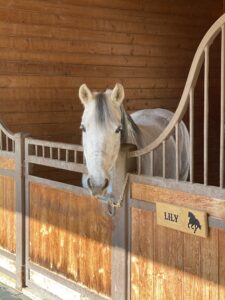 My trainer and good friend Janet called me one afternoon in July. “Marino says Lily is bleeding.” Her voice was tight, strained. “He says there’s a lot of blood.” Lily is a gray Azteca mare. Marino is the man who feeds my horses and mucks out the stalls.
My trainer and good friend Janet called me one afternoon in July. “Marino says Lily is bleeding.” Her voice was tight, strained. “He says there’s a lot of blood.” Lily is a gray Azteca mare. Marino is the man who feeds my horses and mucks out the stalls.
“I’ll go over there now,” I said.
“Call me when you get there. I’ll come in if it’s as bad as he says.”
When I arrived at the barn, Lily stood at her stall door. She looked alert, her ears pricked up, her eyes clear.
Inside her stall, I found blood smeared on the wall and crimson stains in the wood shavings of her bedding. Lily’s lush white tail was soaked red, and blood stained her back legs.
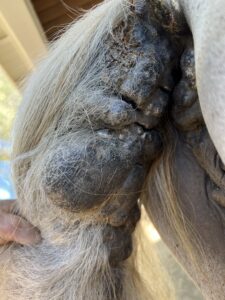 I lifted her tail. On its underside near the top, a black tumor the size of a crab-apple had burst and gushed blood.
I lifted her tail. On its underside near the top, a black tumor the size of a crab-apple had burst and gushed blood.
Looking at the blood in the stall and on Lily, I pieced together what happened. The huge tumor caused Lily discomfort. She backed up against the wall and rubbed the tumor against it, pushing so hard it ruptured.
Lily is 16. I bought her when she was 8. Her previous owner abused her. When we brought her home, she was afraid of men – me, the vet, Marino. Janet was able to work with her, but when I approached, she ran to the other side of her corral and stared at me fearfully.
I visited her every day, talked softly to her, and plied her with treats. About two weeks into it, she finally allowed me to touch her. See Lily’s Song for the full story.
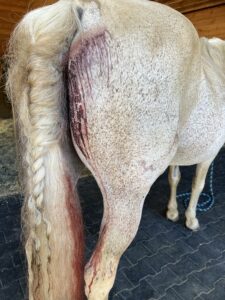 Shortly after that, I found two small hard knots on her shoulder. Years earlier I’d seen growths like that on my dog. I knew what they were.
Shortly after that, I found two small hard knots on her shoulder. Years earlier I’d seen growths like that on my dog. I knew what they were.
I called the vet. In addition to the knots, he found a string of marble-sized black lumps on the underside of Lily’s tail. He confirmed my fears. “Lily has melanoma,” he said.
Equine melanoma is common among gray horses. About 80 percent of them become afflicted with it at some point in their lives. The cancerous tumors are usually located on the lips, around the eyes, along the neck, or on the underside of the tail. Over time, the tumors often multiply and grow larger.
There is no cure, but if the tumors don’t attack vital organs or impede bodily functions, a horse with melanoma may live to old age without significant adverse effects.
“Is there anything we can do to improve Lily’s chances?” I asked the vet.
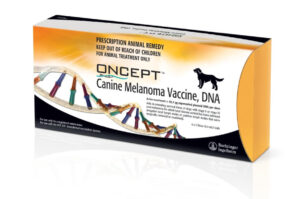
“There’s a vaccine for dogs,” he said. “Some dog vets will prescribe it off-label for horses. It doesn’t eliminate the tumors in horses, but it sometimes slows their growth. It’s expensive, and it often doesn’t work. Most owners let the cancer take its course and hope it doesn’t kill the horse.”
At my vet’s request, a dog vet prescribed the vaccine for Lily. We gave her shots every six months for the next six years. It seemed to work. The tumors didn’t grow much and remained confined to the underside of her tail.
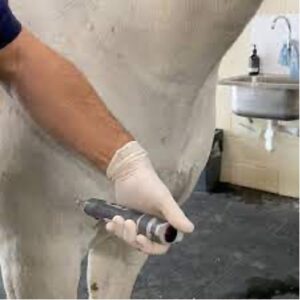
Two years ago, production problems severely curtailed the supply of the drug. All off-label prescriptions for horses were terminated. The dog vet cut Lily off. We couldn’t get the drug anywhere.
Without the vaccine, Lily’s tumors grew rapidly, ballooning to the size of ping-pong balls, and spread over the entire underside of her tail in one conjoined mass.
In July, several large tumors erupted, oozing a brown pus that ran down Lily’s tail. The vet said there was nothing we could do other than clean her wounds, try to control the infections, and hope they heal.
They did not. Foul-smelling pus drained from them almost continuously. Wearing plastic gloves and facemasks, Janet and I washed and disinfected them every day. Then, the biggest tumor ruptured and bled.
She stood perfectly still at the wash rack while I bathed the bloody tumor in warm water. It stopped bleeding, and I coated the wound with an antiseptic cream. Although the sores on her tumors had to be painful to the touch, Lily hadn’t flinched through all our efforts to treat them, and she didn’t flinch that day. She seemed to know we were trying to help her.
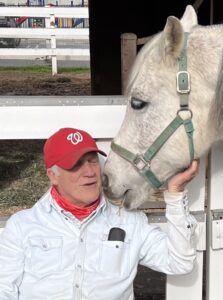 In bed that night trying to find sleep, I couldn’t stop thinking about Lily. Life dealt her a cruel hand. Her previous owner’s abuse caused injuries to her shoulders and legs that never fully healed and contributed to the early onset of arthritis. Her gait is irregular, and she struggles on downhill grades. We give her medication daily to ease the pain.
In bed that night trying to find sleep, I couldn’t stop thinking about Lily. Life dealt her a cruel hand. Her previous owner’s abuse caused injuries to her shoulders and legs that never fully healed and contributed to the early onset of arthritis. Her gait is irregular, and she struggles on downhill grades. We give her medication daily to ease the pain.
Her psychological damage runs even deeper. We can’t erase entirely her memories of the abuse, but Janet and I have earned her trust. We groom her and pet her every day. I spend extra time with her whenever I can, stroking her gently and speaking to her softly. “Good girl. Pretty girl. I’m so proud of you.”
Perhaps because of her dark history, Lily responds to affection with more sensitivity and love than other horses. Janet says she’s the most soulful horse she’s ever worked with. I feel that, too.
I felt it most last summer. The doctors found an extremely aggressive form of dermal melanoma in my shoulder beneath the skin. They were worried it had spread to other parts of my body. I was scared. I went to Lily’s stall the morning after my diagnosis. I stood beside her, my arm over her back, my forehead pressed against her neck. I don’t know if she understood, but it felt like she knew. I visited her several times during the tests and treatment. Although I don’t understand how or why, those visits gave me courage and hope. See The Cancer Club for that story.
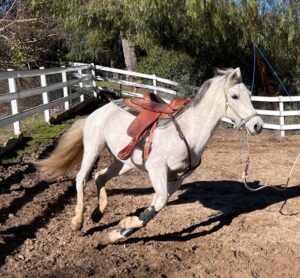 As I lay awake the night after Lily’s tumor burst, I couldn’t shake the feeling I was letting her down. I was cancer-free, but she was still trapped in its constricting grip.
As I lay awake the night after Lily’s tumor burst, I couldn’t shake the feeling I was letting her down. I was cancer-free, but she was still trapped in its constricting grip.
In the morning, I called the vet and asked him to pull out all the stops to find the vaccine. I told him I didn’t care where he had to go or what he had to do. I’d pay to fly it in from anywhere in the world; I’d buy it on the black market; I’d do anything to get that drug. My emotions overwhelmed me, and I broke down.
The vet’s a good guy. He called the dog vet and begged her for the drug. Maybe he cried, too. I don’t know, but whatever he did, it worked.
The dog vet gave us the vaccine, and we resumed the shots in July. My vet also added an antibiotic to Lily’s daily feed, hoping it might heal the draining sores, and Janet tried a new disinfectant spray on the wounds.
The infections cleared. Lily’s condition stabilized. Her energy level returned to normal. Things looked good.
For a little while.
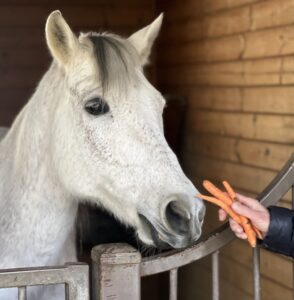 In August, Janet called me over to Lily’s stall. “Something’s wrong,” she said.
In August, Janet called me over to Lily’s stall. “Something’s wrong,” she said.
Lily loves carrots. Janet had given her one. It lay at her feet. She picked it up gingerly with her lips, dropped it, retrieved it, and dropped it again. She couldn’t chew it.
Most horses won’t let you probe inside their mouths and Lily is less trusting than others, but I was able to separate her lips long enough to glimpse a small black lump. My heart sank.
I called the vet. After giving her a tranquilizer, he examined her mouth. “She has tumors inside her jaws on both sides,” he said. “They’re small but there are a lot of them.”
This is the end of the line, I thought. The tumors only impeded her chewing of hard food so far, but I assumed it was just a matter of time until they metastasized and prevented her from eating anything. She would slowly starve, and I would have to confront a heartbreaking decision to end her suffering.
While I struggled to hold my emotions together, the vet continued to probe inside Lily’s mouth.
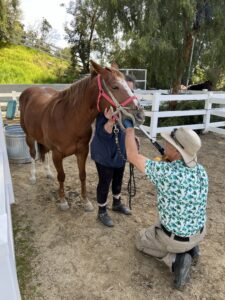
“Her lower molars are long and sharp,” he said, sounding excited. “Remind me, have we ever floated her teeth?”
“No.”
“How old is she?”
“16.”
We stared at each other hopefully.
As horses age, their molars grow and sometimes develop sharp points that make chewing uncomfortable. This usually occurs at about age 15. “Floating” is a dental procedure where the vet uses a power tool, a spinning wafer-sized rasp mounted on the end of a long metal column, to file down the sharp points. Lily was 16, and we had never floated her teeth.
The vet got his rasp, and I held Lily’s head while he floated her back molars.
When the tranquilizer wore off, Lily attacked a batch of carrots with her usual enthusiasm.
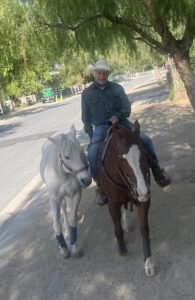 “It wasn’t the tumors,” the vet said. “It was her teeth. If we’re lucky and the vaccine works, the tumors in her mouth won’t grow large enough to become a problem.”
“It wasn’t the tumors,” the vet said. “It was her teeth. If we’re lucky and the vaccine works, the tumors in her mouth won’t grow large enough to become a problem.”
So, Lily lives on. But I’m a realist. Her room in the Cancer Hotel grows darker every day. We’re fighting hard – Lily, Janet, the vet, and I – but cancer is relentless. That dark day I dread so much still lurks out there somewhere.
Meanwhile, I’m trying hard to follow Janet’s advice to live in the present, like Lily does. Lily’s happy and content. She’s eating well and holding her weight. We pony her off Jackson, her favorite buddy, and lunge her in the corral. I groom her every day, stroke her neck and face gently, and speak softly to her. “Good girl. Pretty girl. I’m so proud of you.”
And I tell myself we still have time. We still have time.



October 21, 2025 @ 11:06 am
What a beautiful and touching post, thank you Ken, she is lucky to have you.
October 22, 2025 @ 7:08 am
Thanks, Matt, for reading my blog and for the kind words.
October 20, 2025 @ 7:47 pm
Beautifully and lovingly told. Thank you.
October 21, 2025 @ 7:45 am
Thanks, Jon.
October 18, 2025 @ 7:06 am
Excellent as usual!
October 18, 2025 @ 7:36 am
Thanks, Don.
October 18, 2025 @ 6:16 am
After recently losing our sweet 13 year old puppy, and going through all the emotions of good days and bad, I can understand the feelings that are driven by love and doing whatever it takes. Lily is very blessed to have you and your family, just as you are blessed to have her. Good for you for not giving up! Dan
October 18, 2025 @ 7:35 am
Thanks, Dan. I’m sorry about your dog. I lost my Zoey two years ago. I still dream about her now and again. It is so hard. I don’t want to lose Lily and will do everything I can to keep her going.
October 17, 2025 @ 6:26 pm
She is very lucky to have someone who cares about her. I’m praying for her and for you. God bless you all. I hope she has many more years 🙏. She is a beautiful horse.
October 18, 2025 @ 7:32 am
Thanks very much, Patti, for your prayers and good wishes.
October 17, 2025 @ 2:07 pm
Beautiful. Thanks for sharing ❤️
October 17, 2025 @ 2:15 pm
Thanks, Sonja.
October 17, 2025 @ 12:10 pm
Touched deeply straight to my heart 🙏🏼Lily is a beautiful soul and she’s so lucky to have you 🐴🙏🏼we all are
October 17, 2025 @ 1:43 pm
Lily and I are so lucky to have you. Couldn’t make it through these tough experiences without you.
October 17, 2025 @ 5:51 pm
🙏🏼♥️
October 17, 2025 @ 11:49 am
My flea-bitten gray passed from cancer at age 20ish. She was a wonderful girl and my best horse, ever. The visible melanomas stayed under her tail and were never larger than a pencil’s eraser. Unfortunately, the cancer involved her colon and lower digestive tract. The vet warned us that she would pass more and more gas until she produced more than she could pass. That is exactly what happened. It took years, but eventually she just stood in her corral with her tail lifted, trying to pass a bit more gas. She was very uncomfortable. My last gift to her was a painless death with all my love.
October 17, 2025 @ 1:42 pm
Thanks for sharing about your gray. I’m sorry for the outcome, although it sounds like you had many happy years with her. The vet told me we don’t know if the cancer has attacked Lily internally, so I’ve worried about that, too, especially since we found the tumors inside her mouth. I hope Lily can make it to 20 or more. All we can do is give her the best care possible between now and then.
October 17, 2025 @ 11:03 am
This story reminds me of when we adopted a rescue dog from one of our neighbors 16 or 17 years ago. Our neighbor had rescued a female dog from some acquaintances that she was going to keep as a companion for her dog. However, the two dogs did not get along, so we took her. We had a dog that was about two years older and the rescue dog and he got along reasonably well. The rescue dog would not have anything to do with girls/women for quite a while since apparently one of its previous owners was female who was the abuser. However, things worked out, but the rescue dog always seemed to have an “edge” when around certain folks.
When both dogs got to an advanced age (16 and 14) they began having serious health issues, lashed out at us and others at times, and we could see they were miserable. After a bad episode with the younger (rescue dog) we decided to put them down at the same time even though the vet said she would prescribe medicines to alleviate some of the issues. But the writing was on the wall and we could not justify extending their lives any longer as they were constantly in misery despite anything we could do.
Enjoy Lily and make her life as pleasant as you can. It is great that you have the means and compassion to do so.
October 17, 2025 @ 11:39 am
Thanks for sharing that story, Randy. I’ve fought through cancer with our dogs, too, and had to put two of them down. It’s so hard. The frustrating thing with cancer in horses is there isn’t as much medical knowledge yet. Effective treatments aren’t available beyond the canine vaccine. Lily’s doing okay for now, though. I just hope we can hold it there.
October 17, 2025 @ 10:53 am
Ken-
Thanks for the good cry. Lily is very lucky to have you in her life — and vice versa.
Carpe Diem — and remember now is called the present for a reason.
Love to Lily!
October 17, 2025 @ 11:36 am
Well, you know the horse and me, so you know this has been a tough slog for me. She’s doing pretty well right now. I just hope we can hold the cancer where it is and not let it grow.
October 17, 2025 @ 10:28 am
Awww. I’m so sorry y’all are going through this. It sounds awful. I’ve had a dog and two cats go through this. It’s so hard when you love something so hard and see their pain. I hope the injections continue to work for Lily.
October 17, 2025 @ 11:34 am
Thanks, Rebecca. I lost two dogs to cancer. P.D. had a cancerous tumor last spring. It was surgically removed and he went through four rounds of radiation, but he seems good now. With horses, there just aren’t many good options. I’m hoping the vaccine will give her more time. It’s all we can do.